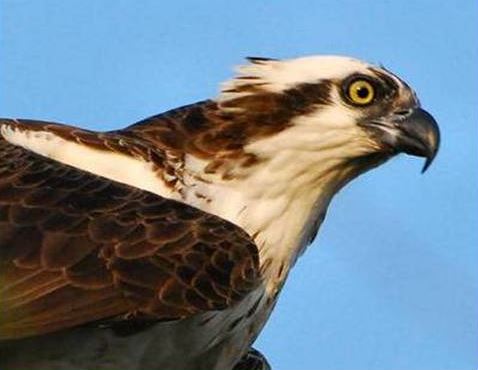Delaware’s osprey population is one of the state’s greatest conservation success stories. From the days of DDT and the collapse of many raptor populations, including bald eagles and peregrine falcons, osprey in Delaware have rebounded and the population continues to grow state-wide.
Jordan Brown
Raptor, Grassland and Forest Bird Biologist
302-255-1960
Now a bird commonly seen during the summer months, the osprey (Pandion haliaetus) can serve as an important environmental indicator and provides insight into issues that may affect it and other coastal birds.
Osprey can be found on every continent but Antarctica. They are found throughout most of North America. In some places they stay year-round and do not migrate.

Ospreys choose habitat with available shallow fishing grounds. This may include rivers, lakes, reservoirs, marsh habitat, and coastline.
An osprey’s diet is about 99% fish which they obtain from water sources (fishing grounds) within 12 miles of their nest site. To help hold the slippery fish, osprey have barbed pads on the soles of their feet.
Osprey prefer elevated nest sites near a water source to avoid predation. Their nest sites may include trees, snags (dead trees), towers, or other man-made platforms.
Nests can span from three feet in diameter and six inches deep up to six feet in diameter and 13 feet deep.
Once these birds lay their one to four eggs, they will incubate the nest for roughly 40 days.
After hatching occurs, nestlings will spend 50 to 55 days at the nest before fledging (flying) from the nest to begin hunting on their own.
The osprey breeding season in Delaware is defined as March 1 through Sept. 30.
You can help osprey by monitoring osprey platforms near your home or workplace. You can submit data to OspreyWatch, an international, online reporting platform hosted by the Center for Conservation Biology.
Public participation in OspreyWatch will allow Delaware to continue gathering data on resident osprey and contribute to a broader regional effort to monitor this species.
If you need help signing up and entering data, see the User Guide for the Delaware Fish and Wildlife Monitoring Group.
For questions about the OspreyWatch website, please contact OspreyWatch directly.
For general questions about osprey, contact DNREC staff at 302-255-1960.

The DNREC Division of Fish and Wildlife does not install or maintain osprey platforms on private or public land.
However, the division does provide guidelines for installing and maintaining platforms. This guidance is based on a design and installation guide from Jodi McLaughlin, with help from Kaitlyn Johnson and Gregory Bird on architectural drawings.
Before a platform can be installed, you must get landowner permission and follow all local, state and federal rules and regulations.
It is important to remember that installing an osprey platform does not guarantee that osprey will nest there. In fact, installing a platform may encourage other species, such as great horned owls or Canada geese, to use them to nest.
Once a platform is in place, avoid visiting it or maintaining it if a nest has been established. Disturbing the nest may prevent the osprey from successfully nesting and raising chicks.
If an osprey reacts to your presence (e.g., calling, flying from the nest), you are too close.
Remove any ladders or similar structures (used to access the nest for maintenance) to prevent predation of the nest.
Found an injured bird?
Contact Tri-State Bird Rescue & Research at 302-737-9543.
The division strongly encourages use of predator guards on platforms.
And if cameras are used for live streaming or monitoring the nest, they also should not be maintained during the breeding season to eliminate disturbance.

Osprey will opportunistically nest on structures such as docks, channel markers, chimneys, duck blinds, and utility poles.
To prevent them from nesting on such structures, you may place excluder devices and/or deterrents on these structures prior to the breeding season (at the latest, mid-February) and before any nest has been built.
Examples of deterrents to use on non-platform structures to exclude all species, including osprey, from nesting include chimney caps, ”spider” or “daddy long legs” wire repellants, or bird of prey (e.g., hawk, owl, eagle) decoys.

When installing excluders on osprey platforms to prevent other species, such as Canada geese, from nesting, be sure the platform is monitored daily for activity.
If your goal is to have osprey nest on this platform, you will need to remove the excluders and any other deterrents as soon as there is evidence of osprey nesting (e.g., sticks present on the platform, pair ponding at the nest site) to prevent disturbance at the nest.
Osprey nests, like all other native, migratory bird nests, are protected by state and federal law.
Nests cannot be moved or removed without state permits, available through the DNREC Division of Fish and Wildlife. For more information, contact Jordan Brown.
Related Topics: conservation, fish and wildlife, osprey, seabirds, volunteer, wildlife